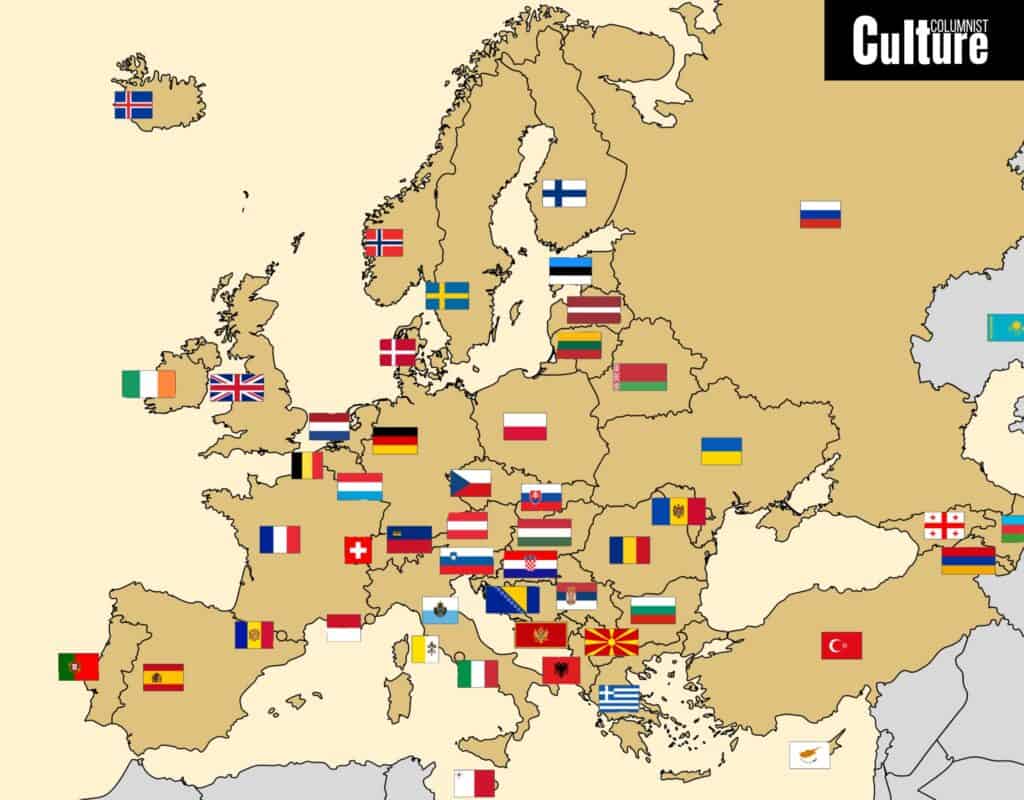How To Plan A Trip To Europe
Traveling Europe by yourself can seem daunting, but with the right approach, it can be an incredibly rewarding experience.
Whether you’re dreaming of a perfect trip filled with iconic landmarks, cozy cafes, and diverse cultures, or you’re considering backpacking Europe with the help of some trains and your own two feet, careful trip planning is key to making the most of your adventure.
This Europe trip planner guide will walk you through everything you need to know about how to plan a trip to Europe.
From finances to choosing when and where to visit, practical considerations such as visa requirements, flights, accommodations, transportation options within Europe, and the finer details like insurance, itineraries, packing essentials and staying connected while abroad should be planned as early as possible.
One of the most fantastic and sometimes overwhelming aspects of planning a trip to Europe is the vast array of options across different regions.
Whether you’re drawn to the historic charm of Western Europe, the scenic beauty of Northern Europe, the rich cultures of Southern Europe, or the emerging destinations in Eastern Europe, there’s something for every type of traveler.
With so many regions to explore, you can craft a European vacation that suits your interests, whether it’s art, history, nature, or adventure.
Below, you’ll find the most important steps to take when considering how to plan a trip to Europe by yourself.
Pro Tip: Bookmark In Your Browser To Keep This Travel Guide At Hand
Table of Contents
Step 1: Define Your Travel Budget
Set up a Europe cost budget early on to help you keep your full travel itinerary both fun and wallet-friendly.
Travel and accommodation costs are higher during the peak season, which includes the summer months of June, July, and August, while traveling in the shoulder seasons (spring and fall) or winter can help you keep these costs down.
It’s important to note that while many European countries use the Euro, accommodation and food costs can vary depending on which country you’re planning to visit.
Western and Northern Europe are typically the most expensive Euro areas of Europe, including Austria, France, Germany and Ireland. Countries like the UK, Switzerland, and some Eastern European nations have their own currencies, so you will need to be aware of the exchange rate for your local currency.
How much does it cost to visit Europe?
While you can enjoy affordable cities in Eastern Europe for €40-70 per day, capital cities in Western Europe and Scandinavia are more expensive, costing €100-200 per day. In Southern Europe, including countries like Italy, Spain, and Greece, you can expect to spend €70-€120 per day.
In central European countries like Switzerland and Luxembourg, which are traditionally the most expensive destinations in Europe, you should plan to spend around €295 (259 Swiss Francs) per day on your vacation in Switzerland.
Step 2: Decide on Your Destinations

Decide how many destinations you want to visit. This will help you figure out how much time you need to manage your itinerary and ensure you get to do everything you want.
Depending on what kind of trip you are planning, it may be beneficial to choose European countries that are relatively close to each other to save time and reduce travel fatigue.
It will also help to determine what kind of transport is best to take between your chosen destinations, such as trains, flights, and buses.
Try to be realistic about how much you can see and do in the time you have. It’s sometimes better to explore one European destination thoroughly than to rush through too many and not get to really experience them.
Remember, Europe is a large and diverse continent with beautiful countries for every type of traveler, so focus on what matters most to you.
Here are some popular destination ideas in Europe that pair well together and can help you make the most of your trip.
- France, Belgium, and the Netherlands offer a mix of art, food, and iconic city architecture.
- Germany, Austria, and the Czech Republic offer a blend of history, classical music, and great beer.
- The United Kingdom and Ireland offer a mix of natural beauty, medieval castles and cosy pubs.
- Norway, Sweden, and Denmark offer insight into Scandinavian culture and Arctic landscapes.
- Portugal and Spain allow you to experience the Iberian Peninsula’s Moorish influences, coastal landscapes, and cuisine.
- Greece and Turkey offer a journey through ancient history and oriental cultural influences.
- Switzerland and Italy offer a mix of dramatic landscapes and plenty of outdoor activities.
- Estonia, Latvia, and Lithuania are great ways to explore the lesser visited Baltic states and their well-preserved medieval towns.
- Hungary, Romania and Bulgaria offer many historic towns with natural hot springs.
How many days do you need to See Europe?
You typically need 3 weeks to 3 months to get a good sense of Europe, depending on your travel style, and the depth of experience you’re hoping to get out of it.
If you’re focusing on major cities like Paris, Rome, Berlin, and London and want to see the main highlights, you might allocate 3–4 days per city with a quick flight between cities. This would mean a trip of at least 2-3 weeks to get a taste of four to five key cities.
Spending 3–4 weeks in a specific region like Western Europe, Central Europe, the Mediterranean, or the Nordic countries is a good way to immerse yourself without the need to take long flights or train journeys between each destination.
Step 3: Apply For A schengen Visa
Non-EU citizens may need a Schengen visa to visit multiple countries in Europe, which allows you to travel freely within the Schengen Area for up to 90 days within a 180-day period.
Countries like the UK, Ireland, Croatia, Bulgaria, Romania, and Cyprus are not part of the Schengen Agreement who have their own visa policies and requirements.
If your itinerary includes both Schengen Zone and non-Schengen, you may need to obtain separate visas so it’s wise to apply for your visa or travel passes as early as possible because processing times can be lengthy.
For those who are planning on backpacking Europe, it’s important to understand how your destinations and the length of your stay will affect your visa requirements.
For example, even though the microstates of San Marino, Monaco, and Vatican City are not official members of the Schengen Zone, entering them is not possible without entering Italy or France first which are part of the Schengen area.
For full details and information about European Visa requirements read our Europe Travel Guide.
Step 4: Plan Your Day-to-Day Itinerary

Plan out the details of your itinerary for your European trip to help maximize the time you have while keeping it manageable and enjoyable.
List out the places you want to add to your itinerary and make a priority list of sites that are the most important for you to visit so that if anything changes, you’ll still get to visit the sites that mattered to you most.
Try not to cram too much into your itinerary and spread out your activities so that you don’t get too much of one thing; for example, make time to visit major cities but also natural landscapes or make time for both relaxation and activity.
Look at a map of Europe and plan a logical route that minimizes backtracking or travelling too many long distances in one go or find a way to make transportation a feature of your Europe itinerary like a train or boat trip between your destinations.
Step 5: Book Your Flights
Booking flights is the moment when your Euro trip becomes a reality. Booking your flights to Europe 2-6 months months in advance can help you secure the best prices but prices are typically higher during peak travel seasons like summer (June-August) and the winter holidays.
Use online flight comparison websites, such as Google Flights, Skyscanner, or Kayak, to compare prices across different airlines and find the most direct routes to your destination.
Europe has several budget airlines, like Ryanair, EasyJet, and Wizz Air, that offer frequent low-cost flights within the continent.
It’s also important to research transportation from your arrival airport to your final destination. Some airports are well-connected to city centers by public transport, while others require taxis and longer transit times.
Step 6: Arrange Your Accommodation

There is a wide range of accommodation in Europe, from high quality hotels, vacation rentals, bed and breakfasts, and boutique hotels to more budget-friendly options like Airbnb, hostels and couchsurfing.
Remember, the cheapest option in your destination may not always be the best value if it’s far from attractions, leading to more travel costs and less time available to explore.
While Europe is generally safe, certain cities may have neighborhoods that are considered less safe than others, so it’s important to do some research about the European city you’re traveling to before you book.
Pay attention to the ratings and reviews from other travelers on platforms like Trip Advisor or Google Reviews to get valuable insights.
Booking websites like Booking.com, Expedia, and VRBO are useful for comparing prices and finding good value budget accommodation. Read our step-by-step guide on booking hotels in Europe.
Step 7: Consider Travel Insurance
Good travel insurance for a trip to Europe is essential. It provides peace of mind and protection against events that are out of your control.
The cost of insurance is small compared to the potential costs of medical emergencies or trip cancellations. European healthcare is expensive for non-residents, so travel insurance can cover any potential medical treatments, hospital stays, and even medical evacuation.
When researching types of insurance for your Euro trip, be aware of what is and is not covered. Policies with 24/7 assistance can be invaluable in Europe, especially as not every country in Europe speaks English and you can quickly encounter language barriers.
Understand in advance how to file a claim and what documentation is required and keep the contact information of your insurance provider handy during your trip, along with a copy of your policy.
Step 8: Plan Transportation Within Europe

Deciding how you want to travel within Europe is essential to your travel planning, particularly if your trip consists of multiple destinations. Most major European cities have efficient public transport systems with multi-day passes that can get you around the city.
Consider buying the Eurail pass if you’re planning to travel to multiple mainland countries, as it will save you time and money while you’re on your trip.
Renting a car in Europe can be a great way to explore Europe’s more rural areas but the majority of rental cars in Europe have a manual transmission. If you are only used to driving automatic vehicles, it’s vital to book in advance.
If you’re planning a road trip, be aware of different driving rules and regulations in each country, including right-hand vs. left-hand driving.
Depending on your home country, you may need an International Driving Permit (IDP) in addition to your driver’s license.
Budget airlines like Ryanair and EasyJet can be great for cutting down travel time between long distances but it’s important to be mindful of their strict baggage restrictions and additional fees if you’re travelling with a lot of luggage.
What is the best method to travel around Europe?
Train travel is considered the best method to travel around Europe. This is because Europe’s rail network is vast and offers both a scenic and fast way to travel without queuing in long lines.
They typically transport you to the centre of a city rather than the outskirts, allowing you to start exploring right away.
However, low-cost airlines like Ryanair and EasyJet are not far behind; they offer affordable and rapid travel between major cities.
They are the most convenient option for covering long distances or when time is limited.Buses are usually the most budget-friendly option to make your way around Europe.
Companies like FlixBus and Eurolines offer bus routes across Europe and provide the best option for budget travelers who want to visit a destination that’s not easily accessible by train.
Here is a list of some of the most popular trip planning apps used in Europe to help you organize transport before and while traveling Europe:
- Omio allows you to compare and book trains, buses, and flights across Europe.
- Rome2Rio gives train, bus, flight, ferry, and car travel options to get from point A to point B.
- Skyscanner compares flight prices across different airlines.
- AZair helps you discover affordable flights across Europe.
- FlixBus offers extensive and affordable bus service across Europe.
- BlaBlaCar is a carpooling app that connects drivers to passengers looking for a ride.
- Uber allows you to book private car rides.
- Cabify is a ride-hailing service similar to Uber.
- FreeNow is a ride-hailing app that offers taxi, e-scooter, and car rental services in Europe.
- Bolt is a ride-hailing app for quick and convenient taxi, scooter, and car-sharing services.
- Bike Share Buddy helps you find and use bike-sharing services in various cities.
- Eurail/Interrail Rail Planner provides train schedules and helps you plan your rail journey across Europe.
- DB Navigator is the app of the German Railway (Deutsche Bahn), offering train schedules, route planning, and ticket booking across Europe.
- Trainline allows you to compare and book train and bus tickets across numerous European rail and bus companies.
Step 9: Book Tours and Activities

Consider which tours and activities you want to do in each destination and how they fit into your overall itinerary. Some tours may be worth a full day trip, while others take just a few hours.
Most major attractions and iconic landmarks in Europe have guided tour options led by locals in English and other major languages.
During peak travel times, attractions are open 7 days a week but it’s important to double check each site’s opening hours as it varies greatly.
Use platforms like Viator, GetYourGuide, Trip Advisor with reviews and ratings to find and book tours and activities in Europe in advance.
Europe is great for offering tours and experiences for specific interests like wine tours, art history tours and many different types of outdoor and adventure escapes.
Pay attention to the physical demands of the activity, especially for adventure tours or walking tours, and remember to balance your tours and activities with some free time to explore each destination on your own.
What are some travel tips for Europe?
Here are some travel tips that can help your European vacation go a lot smoother.
- Learn local phrases and local customs for each destination you’re going to visit to help you navigate and show respect for the local communities. A few basic greetings, such as thank you, please, and other common phrases in the local language of the countries you’re visiting, can go a long way with the locals.
- Stay connected by purchasing a European SIM card to get data and local calling capabilities. The EU has roaming agreements, so a SIM card from one EU country often works in others without extra roaming charges. Otherwise, check with your mobile provider for international plans that include Europe-wide coverage.
- Be careful using public Wi-Fi networks. Consider using a VPN (Virtual Private Network) while on your Europe trip if you plan to use public or communal Wi-Fi.
- Make copies of important documents and keep them separate from your original documents as a safeguard against the loss or theft of your documents. It’s good to know the contact details of your country’s embassy or consulate in the countries you’re visiting as they can assist you in case of an emergency.
- Pack appropriately and make sure you at least have the essentials for your trip such as the proper electrical adapters for the country you’re visiting, well-fitting shoes and travel gear for walking, and luggage that is easy to carry if necessary as you will often find cobblestone streets and stairs in European cities and remember to leave some space for souvenirs.
Create a travel checklist before you leave to help you have peace of mind, knowing you are well-prepared. This final review helps prevent any last-minute issues or forgotten items and allows you to focus on enjoying your European travel adventure.







